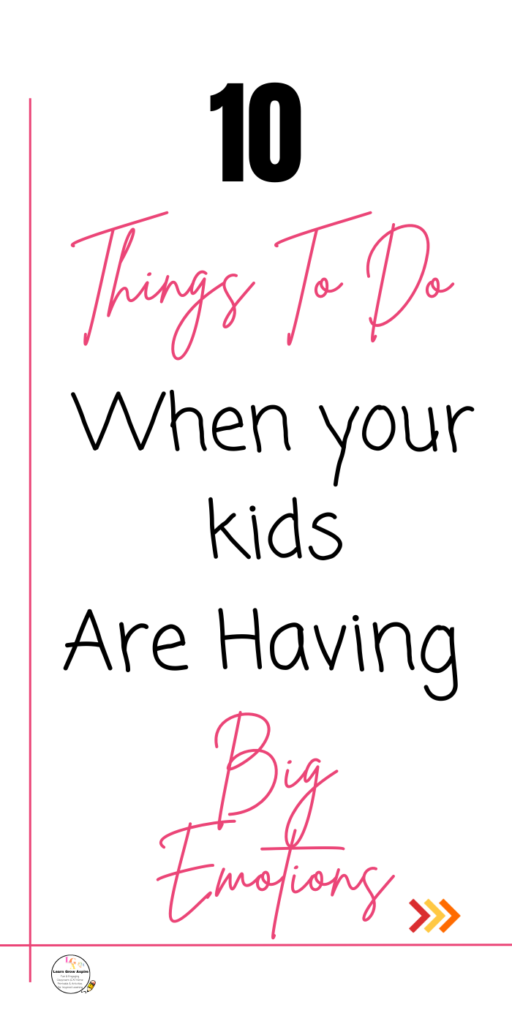Valuable tips and ideas on what you can do when your kids are having big emotions.

What To Do When Your Kids Are Having Big Emotions
Temper tantrums, a wave of sadness, frustrations, or an overwhelming burst of excitement often leave us parents feeling emotionally and mentally draining.
These moments are intense for both us and our kids. Today, I’m sharing effective strategies you can use to help your child manage and understand their emotions, turning potentially chaotic moments into valuable learning experiences.
Let’s dive right in!
1. Stay Calm and Centered
I know, this is easier said than done, but staying calm and centered is key.
When your child is having a meltdown or experiencing strong feelings, your own emotional state plays a crucial role.
You see, your child often looks at you to gauge how they should react. If you stay calm and collected, you help create a stabilizing influence.
So the next time a difficult situation arises, pause, take deep breaths, and give yourself a moment to center before responding.
Your calm demeanor will not only help de-escalate the situation but also model emotional regulation for your child.
2. Validate Their Feelings
One of the most powerful things you can do is to validate your child’s emotions.
Acknowledge their feelings without judgment or immediate solutions. You might say, “I can see you’re really upset right now. It’s okay to feel this way.”
Validation helps children feel understood and less isolated in their emotions, which is the first step toward finding a constructive way to manage them.
3. Use Empathetic Listening
Active listening is key when dealing with big emotions.
Get down to your child’s level, make eye contact, and show genuine interest in what they’re saying. Reflect on what you hear your child saying by saying things like, “It sounds like you’re really frustrated because you didn’t get to finish your game,” for example.
This not only helps your child feel heard but also encourages them to express their feelings more clearly.
4. Teach Emotional Vocabulary
Helping your child articulate their emotions can empower them to handle feelings more effectively.
Use age-appropriate language to expand their emotional vocabulary. Introduce terms like “frustrated,” “disappointed,” or “overwhelmed,” and explain what these words mean. Over time, your child will become more adept at identifying and communicating their emotions.
5. Create a Calm-Down Plan
Having a calm-down plan can be a lifesaver for those moments when emotions run high.
Work with your child to create a set of strategies they can use when they feel overwhelmed. This might include taking deep breaths, counting to ten, or going to a quiet space to relax.
Having a plan in place allows your child a sense of control and a concrete way to manage their feelings.
6. Encourage Problem-Solving
Once the intensity of the emotion has passed, engage your child in problem-solving.
Ask questions like, “What do you think we can do differently next time?”
This helps your child understand that while their feelings are valid, they also have the power to influence their situations and responses. It fosters resilience and critical thinking skills.
7. Model Healthy Emotional Expression
Children learn a lot by observing their parents.
Model healthy ways to express and manage emotions. Show them that it’s okay to feel upset or angry, but also demonstrate how you cope with these feelings constructively. This might involve talking about your own feelings openly, using calming techniques, or seeking support when needed.
8. Provide Reassurance and Consistency
Children need to know that their emotions are manageable and that they have your support. Reassure them that it’s okay to have big feelings and that you are there to help them through them.
Consistency in your responses and routines provides a sense of security, which can be comforting when emotions are intense.
9. Use Books and Stories
Books and stories can be excellent tools for helping children understand and manage their emotions. Choose books that deal with various feelings and discuss the characters’ experiences and solutions with your child. This can provide both a distraction and a valuable lesson on emotional intelligence.
Here are some of our favorite SEL read-alouds.
10. Seek Professional Help if Needed
Sometimes, big emotions can be a sign of underlying issues that might require professional support.
If you notice that your child’s emotional struggles are frequent, intense, or impacting their daily life, don’t hesitate to consult a child psychologist or counselor. Professional guidance can provide additional tools and strategies for both you and your child.
Conclusion
Helping your child navigate big emotions is an ongoing journey, one that requires patience, empathy, and proactive strategies. By staying calm, validating their feelings, and teaching them to manage their emotions effectively, you’re not only helping them cope with the present moment but also equipping them with lifelong skills.
Embrace these moments as opportunities for growth and connection, and remember that with each challenge, you and your child are building a stronger, more resilient relationship.
You May Also Like These Posts:
- How to give emotional support to your child
- How to teach gratitude to your kids
- How to empower the little girls in your life
Pin What To Do When Your Kids Are Having Big Emotions
Head to your parenting Pinterest board and save these what to do when your kids are having big emotions tips.

Some of the links in this post may be affiliate links. I’m also an Amazon Affiliate and will occasionally link to some of my favorite Amazon products. I will receive a small percentage back if you purchase through my link. You won’t be charged a penny more if you shop through my links. That said, I do NOT recommend anything I do not use and love! Thank you for helping support my blog!
